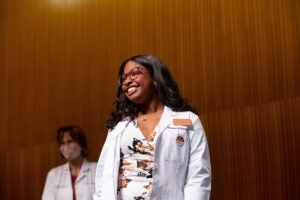John Wallingford and Tim George work at different ends of the biomedical health care spectrum.
Wallingford is a scientist doing basic research at the university. Using frogs and mice as models, he studies how embryos develop and what can go wrong in development.
George is a pediatric neurosurgeon at Dell Children’s Medical Center of Central Texas. Among his patients are children with birth defects.
The scientist and the surgeon have teamed up to find ways to translate the basic discoveries made in Wallingford’s laboratory for use in George’s examination room. They want to reduce birth defects, particularly neural tube defects (NTD), the second most common class of birth defects behind heart problems. Spina bifida, a condition in which the spine does not close completely, is an NTD.
Watch a video interview of Wallingford and George. Video produced by Christina Murrey, 2009.
The work of turning lab discoveries into therapies will take place in the Dell Pediatric Research Institute (DPRI), where other researchers will work to bridge the distance from Wallingford’s laboratory bench to George’s hospital bedside.
“We are two bookends,” Wallingford said. “If we can fill in the center, we will have the group in place to really do something great.”
“You need to cover the whole spectrum,” George said. “That really makes what you do, all of it, productive.”
It’s a bit unusual for a basic scientist and a physician to develop a close working relationship and perhaps especially so for Wallingford and George. When they met in 2003, Wallingford was in Texas and George was at Duke Medical School in North Carolina.
Their mutual interest drew them to the International Neural Tube Defects Conference. It brings together people from a range of disciplines interested in addressing birth defects. There are basic biologists such as Wallingford and clinicians such as George as well as animal and human geneticists, public health officials and others.
Dell Children’s Hospital brought George to Austin as the head of pediatric neurosurgery in 2006.
“One of the attractions of coming here was the fact that John was here,” George said. “I knew the sort of work he was doing and that was an attraction.”
George received an appointment as an adjunct professor in the Section of Molecular Cell and Developmental Biology at the university.
The Collaboration
To mix metaphors, what the bookends needed was a bridge.
“I’ve worked in basic science and John has some translational work,” George said. “We have to figure out a way to marry those two together.”
As Wallingford and George were plotting their birth defect research, the Michael and Susan Dell Foundation was planning to work with The University of Texas at Austin to open a research institute to address children’s health.
“It’s great to be in the right place at the right time,” George said, “because the research institute was being developed and built and that, to me, was a great sign that there was an opportunity for having a physical space right adjacent to the hospital, which was designed to be collaborative to the hospital.”
The thing is, George and Wallingford might not work directly together. Wallingford would, in effect, hand off his research results to the scientists in the institute and they would hand off to George (not including clinical trials, governmental approvals and a long list of other requirements).
Here’s how Wallingford sees the collaboration, at least part of it, working:
“Tim has access to patients, he brings them in, he sees them, we have a human geneticist in the DPRI. Tim sees patients. That gives us additional access to biological samples. The human geneticist identifies the genes that are involved in the different deformities that Tim sees. My lab figures out what those genes do, that gives us insight into how we can change it.”
Besides the diagnostic and therapeutic advances that might result from their collaboration, George and Wallingford see it having a long-term impact on the basic scientist-clinician relationship.
Students working with them can move back and forth between basic and applied research and help develop a common language that hasn’t been spoken before.
“What I really enjoy is the fact that he has a shared vision,” George said of Wallingford. “He has the same passion. We actually get along and that makes it fun. I think there are a lot more relationships that can happen like that. But no one has even been in a place that can get together and talk. That’s where I think the DPRI comes into play.”
Read the full story on the Further Findings blog.



